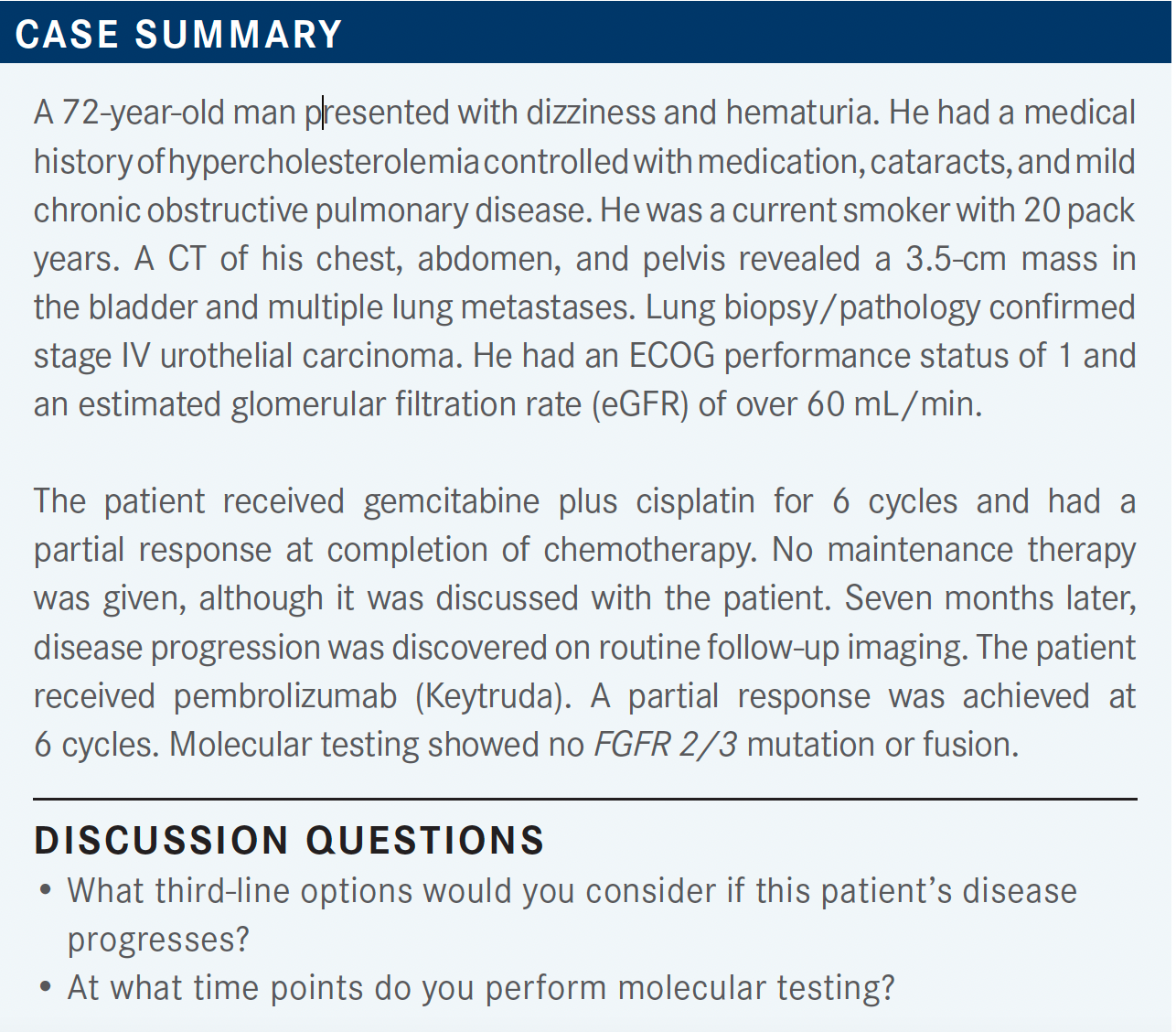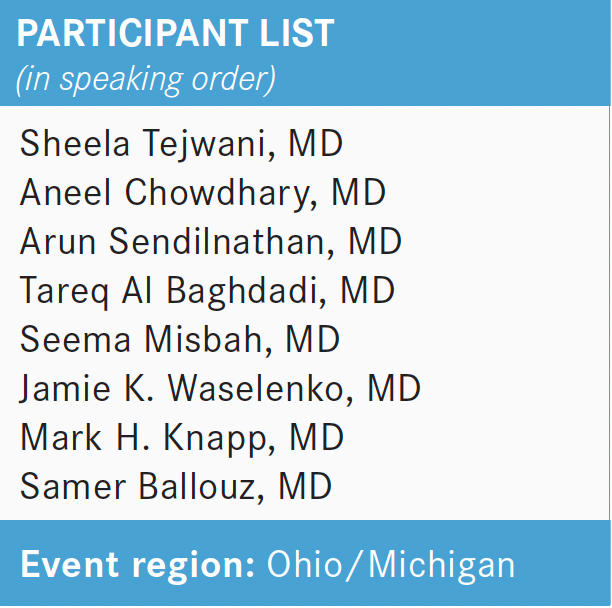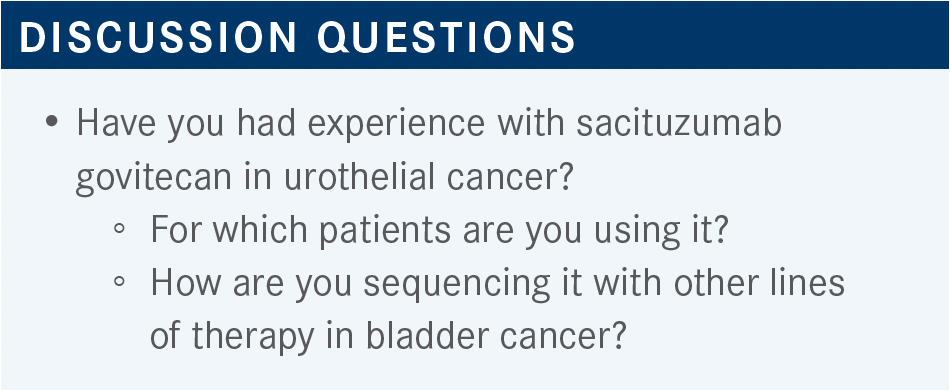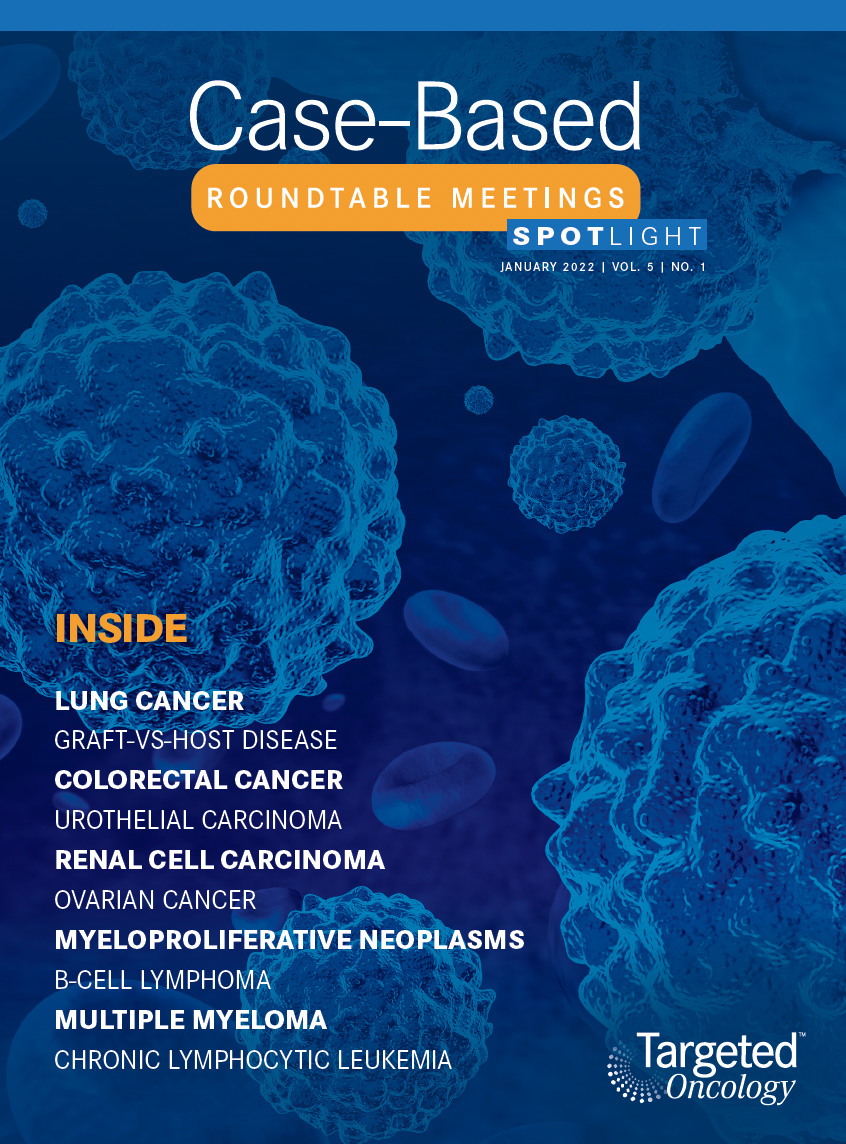Gupta and Participants Review Later-Line Therapy in Bladder Cancer
During a Targeted Oncology Case-Based Roundtable event, Shilpa Gupta, MD, discussed new options for late-line therapies including FGFR inhibitors in patients with bladder cancer.

Shilpa Gupta, MD (Moderator)
Taussig Cancer Institute, Cleveland Clinic


TEJWANI: We have been using enfortumab vedotin-ejfv [Padcev] for third-line [therapy at my institution]. Enfortumab has a good response rate and after failing cisplatin and an anti–PD-L1, I would move to enfortumab.
For the molecular testing, we are doing much of it up front. Once they have metastatic disease, we either send it to Tempus or FoundationOne, or do it in-house.
GUPTA: Are you doing next-generation sequencing [NGS] as soon as the patient develops metastatic disease?
TEJWANI: Correct.
CHOWDHARY: We discuss with [the physicians at] the main campus as well. I think our approach is very similar to what Dr Tejwani outlined. We do molecular testing pretty much at the outset when they have the diagnosis of stage IV disease. I think for the majority of our cases, once they’ve progressed beyond a platinum and PD-L1 inhibitor, then we do go on to enfortumab. That is one of the regimens. We have sacituzumab govitecan-hziy [Trodelvy] as well now. If they have a FGFR alteration, which this patient did not, then erdafitinib [Balversa] would be an option there too. But enfortumab is what most of us are utilizing at this point.
GUPTA: Let’s say the patient has significant neuropathy after the platinum chemotherapy. In that case do you consider sacituzumab?
CHOWDHARY: Yes, absolutely. In fact, I have a patient right now who didn’t have any neuropathy. He was on enfortumab and had a very good response. But after 5 months, he developed significant [neuropathy] in his fingers and feet especially, a lot of fatigue, and nerve damage. We are giving him a break where we are considering sacituzumab now going forward.
GUPTA: Anyone else want to chime in as to when you perform molecular testing or if your third-line options are something different from enfortumab or erdafitinib in case there’s FGFR2/3 alterations?
SENDILNATHAN: I’m one of the community oncologists from Hamilton, Ohio. Everybody mentioned performing molecular testing up front, which is definitely the case for us. If we do molecular testing up front and find a FGFR mutation, we are still using the FGFR inhibitor as a third-line [treatment], right, not using that in the front line? If you’re going through the process of first-line and second-line therapy, and then they progress after that second line, which still could be a year to a year and a half…, then would you retest to make sure the FGFR is still there? Or would you use the FGFR status from the first test and go for enfortumab?
GUPTA: The original FGFR3 inhibitor used archival tissue. Ideally, yes, we want to have a biopsy of the newest lesion, but it’s not always feasible. But we also know that sometimes there can be a delay with getting the readout on these. I think it’s still a great practice to perform it when patients have metastatic disease and use that information for whenever you have to use erdafitinib. I don’t think we need to redo the biopsy unless you’re trying to understand mechanism of action of resistance to any particular agent.
AL BAGHDADI: One other treatment option I wanted to add is the clinical trial. I recently enrolled [one of my patients] in a trial assessing eribulin vs eribulin plus gemcitabine. The patient was assigned to eribulin alone. [There was] good activity in earlier trials, but neuropathy remains the rate-limiting problem.
GUPTA: Clinical trials are always the preferred option whenever we can offer it to our patients.

GUPTA: For subsequent lines of systemic therapy, the NCCN also propagates clinical trials of new agents. Preferred regimens include enfortumab in category 1, and erdafitinib, based on the phase 3 pivotal trials. Other recommended regimens are a variety of chemotherapy agents. I think with the recent accelerated approval of sacituzumab, an antibody-drug conjugate, that is being preferred over other agents. But the phase 3 trial [NCT03547973] confirming the sacituzumab activity is going on, comparing it against the salvage chemotherapy regimen.
This brings us to the accelerated approval for sacituzumab that happened on April 13, 2021.2 This was based on the single-line trial for patients who received sacituzumab after progressing on a platinum-containing chemotherapy and a checkpoint inhibitor.
The mechanism of action—trop-2—is an epithelial cell surface antigen, which is highly expressed in urothelial cancer. Sacituzumab is also an antibody-drug conjugate, but this is different from enfortumab. This is directed against trop-2 to get a high drug-to-antibody ratio and there’s a bystander effect due to the hydrolyzable linker hydrolysis. The linker for SN-38, which is the payload, is more potent than the parent compound, irinotecan. And the linker is the hydrolyzable [linker hydrolysis] for the payload release. Then there’s the humanized antitrope to antibody, which is directed against the trop-2, which is the epithelial antigen expressed across a variety of cancers and also in urothelial cancer.

MISBAH: I haven’t used [sacituzumab govitecan] as of yet, but I’m planning on using it as third line after enfortumab.
TEJWANI: I have used it. I currently have a patient who had a kidney transplant in 1982 and has new liver metastases treated previously 5 years ago with cisplatin and gemcitabine. She cannot go on immunotherapy because she doesn’t want to lose her kidneys. Sacituzumab was approved by her insurance company, so we have not used enfortumab. She has completed 3 cycles and she’s waiting to have a CT scan.
She did have some diarrhea. We reduced her dose to 75% [in the] first cycle, then after the second cycle that she tolerated, we went to full dose.
GUPTA: You titrated it up, and diarrhea was fine with supportive [care]?
TEJWANI: It was grade 2. It was manageable with hydration, and she had pulled through pretty well on this chemotherapy.
CHOWDHARY: At this juncture, aside from preexisting conditions that may preclude using enfortumab, when you’re in this third-line setting—say if there was a patient with FGFR wild-type disease—how are you deciding between enfortumab and sacituzumab? Aside from preexisting issues, are there any other clinical factors that lead you to decide between the 2?
GUPTA: I go by their preexisting toxicities from prior therapy. Primarily in patients who had platinum therapy, if they have substantial neuropathy, then I like to avoid enfortumab because that can exacerbate the neuropathy and then it becomes irreversible. If you give them time to recover from that while you use sacituzumab in those patients, that is what I would do. If the neuropathy gets better, and if they progress on sacituzumab, then I use enfortumab. But the approval is fairly recent and we’re all still learning the sequencing on a case-by-case basis.
Dr Al Baghdadi, do you have any experience on how you are sequencing it, if you have used this?
AL BAGHDADI: I’ve only used it in breast cancer so far, but in bladder cancer, use of enfortumab is not required prior to sacituzumab.
The only thing is that the response rate—we’re comparing across trials here—was higher with enfortumab vs sacituzumab. Neuropathy’s a big problem because that would be the main determinant in my clinic. If they have no severe neuropathy, they’re going to get enfortumab; severe neuropathy, they’re going to get sacituzumab. I think going forward it’d be nice to see the expression of trop-2 and nectin-4 on different subsets of bladder cancer. There was a publication in 2020 showing that nectin-4 is fully expressed in sarcomatoid and adenocarcinoma, a variant of bladder cancer.3 I was hoping to see in squamous cell, in plasmacytoid, there might be differential expression when we prefer one over the other, based on that expression, but such data do not exist yet.
GUPTA: You’re right, that would be good to know. Most of the trials focus on urothelial predominance. The thing with neutropenia is we can prevent it with growth factor use like we do with chemotherapy, but we can’t prevent neuropathy, unfortunately. That is my deciding factor, because I believe that every patient should get to receive all the therapies that we have at some point. How best to use them in sequence [is decided] case by case, purely.

GUPTA: Are you doing anything different for that than you do with chemotherapy? Are you using prophylactic growth factors? How do you manage the diarrhea? Dr Tejwani mentioned they’re doing hydration if patients have some diarrhea. I want to get the group’s thought on how you prepare for them to get through the toxicities, of which the key ones are neutropenia and diarrhea.
AL BAGHDADI: I would use the growth factors for neutropenia. This is an intermediate-risk drug, so I wouldn’t use prophylaxis for all patients, but if they have other risk factors or they’re older, I would use it. The patients with breast cancer I’ve treated so far, I send them home with Imodium [loperamide] and antiemetics to be used as soon as they have any hint of nausea or diarrhea. I’ve decided against Imodium so far for these patients, given the grade 3 toxicity of 9%. We stress hydration. We ask them to call if there’s any possibility of dehydration so we can give them intravenous fluids, and I’m quick to reduce the dose if needed.
GUPTA: It looks like everybody’s using the guidelines in how we would manage diarrhea and neutropenia from any of the therapies, like chemotherapy.
Severe neutropenia is grade 4 neutropenia for a week or more, grade 3 febrile neutropenia, which by definition is a neutrophil count of less than 1000, or grade 3 or 4 neutropenia which delays dosing by 2 or 3 weeks for recovery to grade 1 or lower.
On the first occurrence, we reduce the dose by 25% and give growth factors. At the second occurrence, we reduce by 50%. At third occurrence, we permanently discontinue treatment. It’s at the discretion of the treating physician, depending on the patient’s comorbidities.
[For] grade 3 or 4 neutropenia at the time of scheduled treatment, if it delays treatment beyond 3 weeks for recovery at the first occurrence, you can discontinue treatment, given there can be serious consequences of sepsis. Severe non-neutropenic toxicity is grade 4 toxicity of any duration or grade 3 or 4 of nausea, vomiting, or diarrhea, primarily the gastrointestinal toxicities which you tried antiemetics or antidiarrheal agents for. Also, [for] any other toxicity which persists for 2 days or more despite optimal management, or any nonhematologic toxicity which delays treatment by 2 or more weeks, again, we follow the same principle. The first time it happens, decrease it by 25% and a second time, 50%. [If it happens a] third time, discontinue [treatment]. If you have [toxicity] at the get-go, the first time you would get that severe toxicity, you’d discontinue treatment.
WASELENKO: For severe neutropenia for first occurrence, it talks about using a subsequent 25% dose reduction and administration of growth factor support, and then it says for second occurrence, 50% dose reduction. It does not mention growth factor support. I would think you would continue growth factor support.
GUPTA: Yes, I think after the first occurrence you’ll continue the growth factor for the future.

GUPTA: [This patient received gemcitabine plus cisplatin with partial response, then] pembrolizumab and had a partial response. The big question now is what factors influence your decision to use sacituzumab or enfortumab in the third- or late-line setting. Let’s say he had bad myelosuppression from chemotherapy: Would you be comfortable using sacituzumab or would you be hesitant? Or would you use prophylactic growth factor then go ahead and use this?
I think we touched upon the fact that if patients have severe neuropathy, you would avoid enfortumab and go with sacituzumab. Would you go by site of metastases or any other factors? What do you do to discuss these treatment options with your patients?
KNAPP: I would take his comorbidities into account and if he has ocular toxicities, if he has preexisting [comorbidities], those would play a role. I don’t know so much about site of metastasis. I don’t know if there are any data that say site of metastasis would play a role in the drug you would choose, or biomarker selection as well. I don’t think we’re doing any biomarker testing for either of these drugs. I think the biggest thing would be preexisting comorbidities, in my case, for what I would choose as a third-line agent.
BALLOUZ: I agree. I never used sacituzumab in bladder cancer. But it’s like any other medicine: You’re going to weigh the benefit vs the risk, you’re going to look at the comorbidity, and then you’re going to decide your treatment options. I think this is no exception. We do that all day in oncology, deciding benefit vs the risk and comorbidity, and then we make a decision.
SENDILNATHAN: I think this was a great discussion about the ocular toxicity; when you talk about diabetes, you get a baseline neuropathy. Then you want to be very careful. I think you could tell patients that this is something that can happen, and we could offer that. If it gets worse, then we can always back it off and go for the third-line sacituzumab.
REFERENCES
1. NCCN. Clinical Practice Guidelines in Oncology. Bladder cancer, version 6.2021. Accessed December 10, 2021. https://bit.ly/3IIkLe3
2. Hoffman-Censits JH, Choi W, Lombardo K, et al. Expression of nectin-4 in bladder cancer with variant histology. J Clin Oncol. 2020;38(suppl 6):546. doi:10.1200/JCO.2020.38.6_suppl.546
3. Hoffman-Censits JH, Lombardo KA, Parimi V, et al. Expression of Nectin-4 in Bladder Urothelial Carcinoma, in Morphologic Variants, and Nonurothelial Histotypes. Appl Immunohistochem Mol Morphol. 2021;29(8):619-625. doi:10.1097/PAI.0000000000000938

Gasparetto Explains Rationale for Quadruplet Front Line in Transplant-Ineligible Myeloma
February 22nd 2025In a Community Case Forum in partnership with the North Carolina Oncology Association, Cristina Gasparetto, MD, discussed the CEPHEUS, IMROZ, and BENEFIT trials of treatment for transplant-ineligible newly diagnosed multiple myeloma.
Read More
Key Trials From ASH 2024 Impact Treatment for Plasma Cell Disorders Going Forward
February 20th 2025Peers & Perspectives in Oncology editorial board member Marc J. Braunstein, MD, PhD, FACP, discussed the significant advancements in multiple myeloma treatment at the 2024 ASH Annual Meeting and Exposition.
Read More